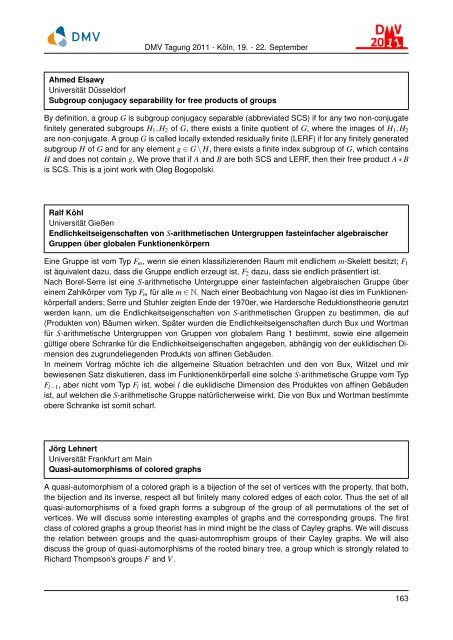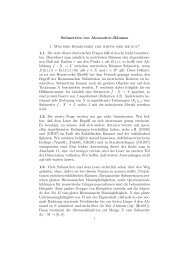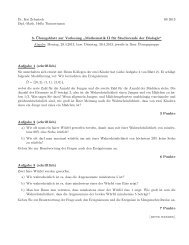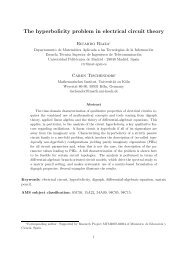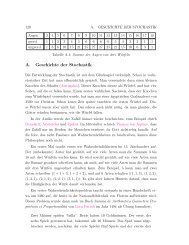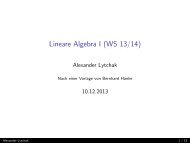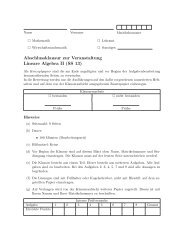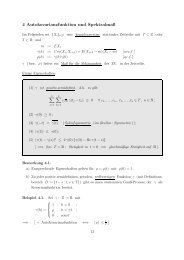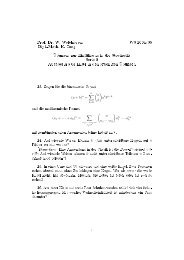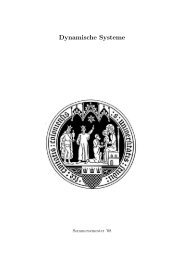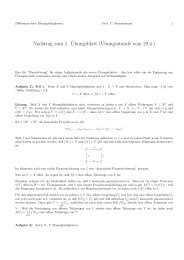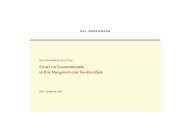Inhaltsverzeichnis - Mathematisches Institut der Universität zu Köln
Inhaltsverzeichnis - Mathematisches Institut der Universität zu Köln
Inhaltsverzeichnis - Mathematisches Institut der Universität zu Köln
Create successful ePaper yourself
Turn your PDF publications into a flip-book with our unique Google optimized e-Paper software.
DMV Tagung 2011 - <strong>Köln</strong>, 19. - 22. September<br />
Ahmed Elsawy<br />
<strong>Universität</strong> Düsseldorf<br />
Subgroup conjugacy separability for free products of groups<br />
By definition, a group G is subgroup conjugacy separable (abbreviated SCS) if for any two non-conjugate<br />
finitely generated subgroups H1,H2 of G, there exists a finite quotient of G, where the images of H1,H2<br />
are non-conjugate. A group G is called locally extended residually finite (LERF) if for any finitely generated<br />
subgroup H of G and for any element g ∈ G \ H, there exists a finite index subgroup of G, which contains<br />
H and does not contain g. We prove that if A and B are both SCS and LERF, then their free product A ∗ B<br />
is SCS. This is a joint work with Oleg Bogopolski.<br />
Ralf Köhl<br />
<strong>Universität</strong> Gießen<br />
Endlichkeitseigenschaften von S-arithmetischen Untergruppen fasteinfacher algebraischer<br />
Gruppen über globalen Funktionenkörpern<br />
Eine Gruppe ist vom Typ Fm, wenn sie einen klassifizierenden Raum mit endlichem m-Skelett besitzt; F1<br />
ist äquivalent da<strong>zu</strong>, dass die Gruppe endlich erzeugt ist, F2 da<strong>zu</strong>, dass sie endlich präsentiert ist.<br />
Nach Borel-Serre ist eine S-arithmetische Untergruppe einer fasteinfachen algebraischen Gruppe über<br />
einem Zahlkörper vom Typ Fm für alle m ∈ N. Nach einer Beobachtung von Nagao ist dies im Funktionenkörperfall<br />
an<strong>der</strong>s; Serre und Stuhler zeigten Ende <strong>der</strong> 1970er, wie Har<strong>der</strong>sche Reduktionstheorie genutzt<br />
werden kann, um die Endlichkeitseigenschaften von S-arithmetischen Gruppen <strong>zu</strong> bestimmen, die auf<br />
(Produkten von) Bäumen wirken. Später wurden die Endlichkeitseigenschaften durch Bux und Wortman<br />
für S-arithmetische Untergruppen von Gruppen von globalem Rang 1 bestimmt, sowie eine allgemein<br />
gültige obere Schranke für die Endlichkeitseigenschaften angegeben, abhängig von <strong>der</strong> euklidischen Dimension<br />
des <strong>zu</strong>grundeliegenden Produkts von affinen Gebäuden.<br />
In meinem Vortrag möchte ich die allgemeine Situation betrachten und den von Bux, Witzel und mir<br />
bewiesenen Satz diskutieren, dass im Funktionenkörperfall eine solche S-arithmetische Gruppe vom Typ<br />
Fl−1, aber nicht vom Typ Fl ist, wobei l die euklidische Dimension des Produktes von affinen Gebäuden<br />
ist, auf welchen die S-arithmetische Gruppe natürlicherweise wirkt. Die von Bux und Wortman bestimmte<br />
obere Schranke ist somit scharf.<br />
Jörg Lehnert<br />
<strong>Universität</strong> Frankfurt am Main<br />
Quasi-automorphisms of colored graphs<br />
A quasi-automorphism of a colored graph is a bijection of the set of vertices with the property, that both,<br />
the bijection and its inverse, respect all but finitely many colored edges of each color. Thus the set of all<br />
quasi-automorphisms of a fixed graph forms a subgroup of the group of all permutations of the set of<br />
vertices. We will discuss some interesting examples of graphs and the corresponding groups. The first<br />
class of colored graphs a group theorist has in mind might be the class of Cayley graphs. We will discuss<br />
the relation between groups and the quasi-automrophism groups of their Cayley graphs. We will also<br />
discuss the group of quasi-automorphisms of the rooted binary tree, a group which is strongly related to<br />
Richard Thompson’s groups F and V .<br />
163


